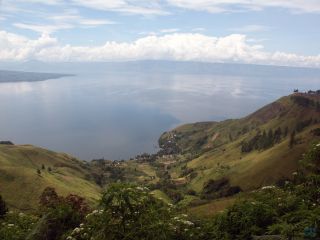Magma 'Pancakes' May Have Fueled Toba Supervolcano

The most catastrophic volcanic eruption in the last 2 million years may owe its superpower to stacks of hot molten rock layered like the jelly filling inside a sky-high wedding cake.
By recording tiny natural vibrations, scientists have built the best picture yet of the Toba supervolcano's underground plumbing.
The magma layers, called sills, start about 4 miles (7 kilometers) below Indonesia's Toba volcano. The discovery suggests the volcano is fed by sills stacked underground between older rock layers, instead of a shallow magma pool such as those typically drawn in volcano cartoons, the researchers said.
The discovery points to a different mechanism behind these rare supereruptions, compared with regular volcanoes that frequently erupt. The study, published today (Oct. 30) in the journal Science, could help explain how supervolcanoes store enormous quantities of magma before their terrifying blasts.
"I think this is a distinctive feature of this volcano, and it's related to the style in which it erupts," said study co-author Christoph Sens-Schönfelder, a seismologist at the GFZ German Research Centre for Geosciences. "The geodynamic models that explain structures like those suggested by our results predict that it takes millions of years to accumulate the required magma volumes," Sens-Schönfelder told Live Science.
One of the most puzzling features of supervolcanoes is their skill at storing massive amounts of magma without bursting. When the Toba supervolcano erupted 74,000 years ago, an enormous 700 cubic miles (2,800 cubic kilometers) of lava and ash spread from Africa to Australia. Even though the last Toba blast spread ash from Africa to Australia, the volcano actually had little effect on climate in East Africa, where modern humans were undergoing an apparent near-extinction, according to recent research. In comparison, the 1883 Krakatoa eruption, one of the largest in recent history, spewed about 3 cubic miles (12 cubic km) of material. [Big Blasts: History's 10 Most Destructive Volcanoes]
Hunting supervolcanoes
Sign up for the Live Science daily newsletter now
Get the world’s most fascinating discoveries delivered straight to your inbox.
Researchers would like to know how the molten rock builds up, and how to track the reloading of supervolcanoes with such magma stores.
"What I find provocative about this paper is that it reports evidence for sill-like bodies at depths that start at or just below the depths inferred for Toba magma storage prior to eruption," said Mary Reid, a volcanologist at Northern Arizona University in Flagstaff, who was not involved in the study. "Sill-like storage of magma could also help to explain why large magma bodies, expected to be present at numerous locations in the world based on probability, might not be recognized using more conventional seismological methods."
The magma reservoir beneath Mount Toba was detailed with ambient seismic noise, which are weak vibrations created by wind, ocean waves and human activities. The seismic waves change speed as they zip through the different kinds of rock, with some waves dramatically slowing in liquid.

According to the analysis, led by Kairly Jaxybulatov of the Trofimuk Institute of Petroleum Geology and Geophysics in Russia, the magma sills extend from 4 miles (7 km) to at least 19 miles (30 km) below Samosir Island in the center of Lake Toba. The magma reservoir is 6 to 12 miles (10 to 20 km) in diameter. Other supervolcanoes that may have a similar structure include Taupo volcano in New Zealand and California's Long Valley Caldera.
Still unclear is the makeup of shallower crust beneath the huge, bowl-shaped caldera. Above the sills, a seismic "slow zone," where seismic wave velocities suddenly slow down, suggests there is a thick sequence of eruption deposits, such as ash and lava, in that spot, the researchers reported. However, other scientists think the same low-velocity seismic data implies a shallow magma chamber instead, according to a study published in 2010 in the journal Geophysical Research Letters.
"I suspect the low-velocity zone represents new magma coming into the system, but it may have also combined with leftover material," said Jorge Vazquez, a research geologist with the U.S. Geological Survey in Menlo Park, California, who was not involved in either study. "It's something that needs to be tested.
The new findings can't help predict when Toba will unleash its next supereruption. "The structure might be different prior to an eruption, but our study just tells about a single moment in the evolution of the volcano, and we do not know in which phase the system is," Sens-Schönfelder said.
Follow Becky Oskin @beckyoskin. Follow Live Science @livescience, Facebook & Google+. Originally published on Live Science.

Most Popular

